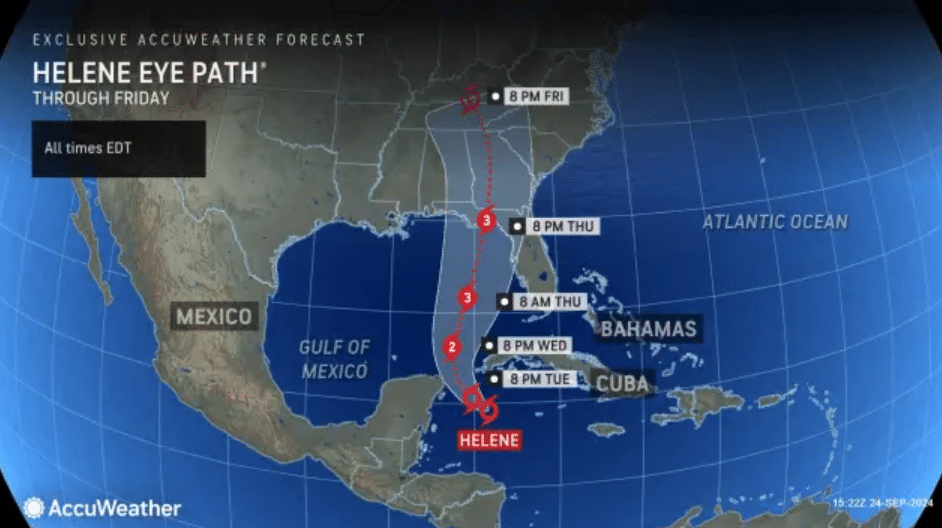A major hurricane is approaching the Gulf of Mexico. AccuWeather meteorologists warn that communities along the central and eastern Gulf coast only have a couple of days to prepare for the fast-brewing, quick-moving Helene’s arrival, which can potentially bring life-threatening storm surge and flooding rainfall, as well as destructive winds.
The western Caribbean to the Gulf of Mexico has been an area highlighted by AccuWeather meteorologists as a hot spot for tropical activity since the middle of September.
Gov. Ron DeSantis declared a state of emergency in advance of the strengthening storm. Officials have expanded mandatory evacuation orders for the barrier islands and some low-lying coastal areas from the Florida Big Bend to near Tampa. A hurricane watch is in effect from Englewood to Indian Pass, Florida, including Tampa Bay. A tropical storm watch is in effect for much of the rest of the Florida Gulf coast, including the upper Florida Keys. A tropical storm warning is in effect for the lower Florida Keys.
Showers and thunderstorms quickly gathered over the weekend in the western Caribbean and adjacent land areas in Central America this past weekend. Localized flash flooding and mudslides will occur in areas surrounding the western Caribbean from Cuba to southeastern Mexico, Belize and Honduras.
AccuWeather began designating the brewing system as a tropical rainstorm this past weekend to raise public awareness and issue its own track map to help people and officials plan ahead.
Helene is currently a tropical storm packing 45-mph sustained winds with higher gusts.
“The combination of deep warm water (ocean heat content) and low disruptive breezes (wind shear), should assist in rapid strengthening when Helene moves over the Gulf of Mexico from Wednesday to Thursday,” AccuWeather Chief On-Air Meteorologist Bernie Rayno said.
“Most likely, Helene will create its own environment and bring a surge in moisture to the currently dry air over the Gulf,” Rayno added. That moistening process was becoming evident in the southeastern Gulf of Mexico on Tuesday.
Helene is forecast to rapidly intensify, with maximum sustained winds increasing by at least 35 mph or more in less than 24 hours.
AccuWeather is expecting Helene to make landfall as a major hurricane of Category 3 strength (sustained winds of 111-129 mph) on the Saffir-Simpson Hurricane Wind Scale. However, it could reach Category 4 status (130-156 mph) at some point while it is over the Gulf of Mexico.
At this time, Helene’s eye is most likely to track onshore along the Gulf Coast from the western part of the Florida Panhandle to the central part of the Florida Peninsula. This landfall window will continue to narrow once a strong storm center forms and begins to move along.
The highest landfall probability is somewhere along the eastern part of the Florida Panhandle–perhaps in the Big Bend area–late Thursday evening. But, a possible track farther to the southeast, over the Florida Peninsula, could mean an earlier landfall Thursday.
People should not just focus on where Helene’s eye could make landfall. The storm will grow significantly in size with impacts that reach well out from the eye, especially on the eastern flank prior to landfall and for a time shortly thereafter.
“This can be a large hurricane with life-threatening impacts such as storm surge and flooding rain hundreds of miles away from where the storm makes landfall – be sure to know the risks you can face in your community,” AccuWeather Chief Meteorologist Jonathan Porter said.
There is a significant risk to lives and property with the upcoming hurricane in the U.S.
Tropical Storm Helene, which will soon become a major hurricane, is initially rated as a 3 on the AccuWeather RealImpact™ Scale for Hurricanes. This scale incorporates much more than the Saffir-Simpson scale, which is based on wind intensity alone.
The RealImpact scale weighs in storm surge, flooding rain, economic loss and population affected in addition to damaging wind gusts and tornadoes produced by a tropical system. It is possible the RealImpact may be pushed higher.
A storm surge of 15-20 feet is anticipated near and just east of where the eye rolls ashore. At this time, the level of storm surge is most likely in the Big Bend area of Florida. However, a significant storm surge of 6 to perhaps 10 feet will occur through the Tampa area and perhaps as far to the west as Panama City, Florida, depending on the hurricane track.
Due to strengthening winds from the southeast that will be perpendicular to the beaches, a storm surge of up to a few feet is also anticipated along the Georgia and South Carolina coasts. Charleston, South Carolina, which is hundreds of miles to the northeast of where Helene will make landfall along the Gulf Coast, could face some inundation.
Wind gusts frequenting 100-140 mph are forecast near and just to the east of where Helene lands, with an AccuWeather Local StormMax™ wind gust of 160 mph.
Strong, damaging winds will reach well northeast of Helene’s center as it moves inland. This includes much of Georgia and South Carolina. Travel could become dangerous from later Thursday to Saturday well inland due to the risk of flooding from torrential rain, falling trees from high winds and possibly even a few tornadoes.
Widespread power outages are anticipated near north and east of where the eye makes landfall.
Near where Helene makes landfall, general rainfall of 8-12 inches is forecast, with an AccuWeather Local StormMax™ rainfall of 24 inches. A pocket of 8-12 inches of rain is also likely in the southern Appalachians and Piedmont.
Even as the storm loses wind intensity after moving well inland, the likelihood of heavy rain will continue. Typically in the hours and days after landfall, the heaviest rain shifts to the north and west of the storm center.
“There is the risk for major flooding in parts of the Southeast late Thursday into Friday, including the Atlanta area as well as the steep terrain of the southern Appalachians, where the flooding risk can be especially elevated as well as the risk for mudslides and rockslides,” Porter said.
In some cases, catastrophic flooding may occur. For example, some locations, including Atlanta, are likely to be swamped with locally heavy rain prior to Helene’s arrival, which could make the situation much worse than if Helene just passed through on its own.
Some of the heaviest rainfall hundreds of miles from the Gulf Coast may steer across the Tennessee, lower Ohio and mid-Mississippi valleys. Flooding along some of the secondary rivers is possible, but a moderate rise on the Ohio and Mississippi rivers would be welcomed by tug and barge operations that cost-effectively transport goods. Low water levels for the third year in a row have been restricting these operations.










